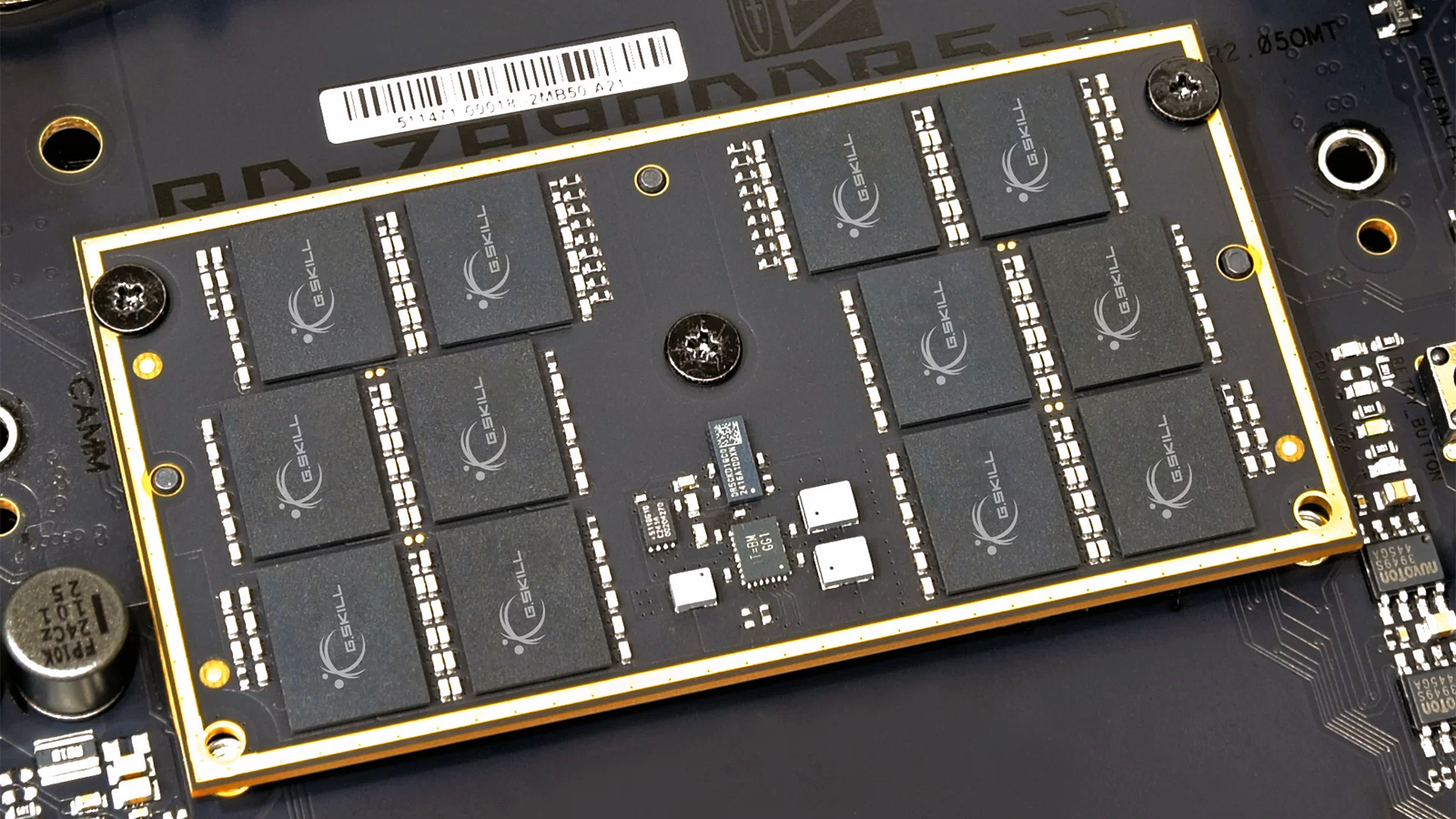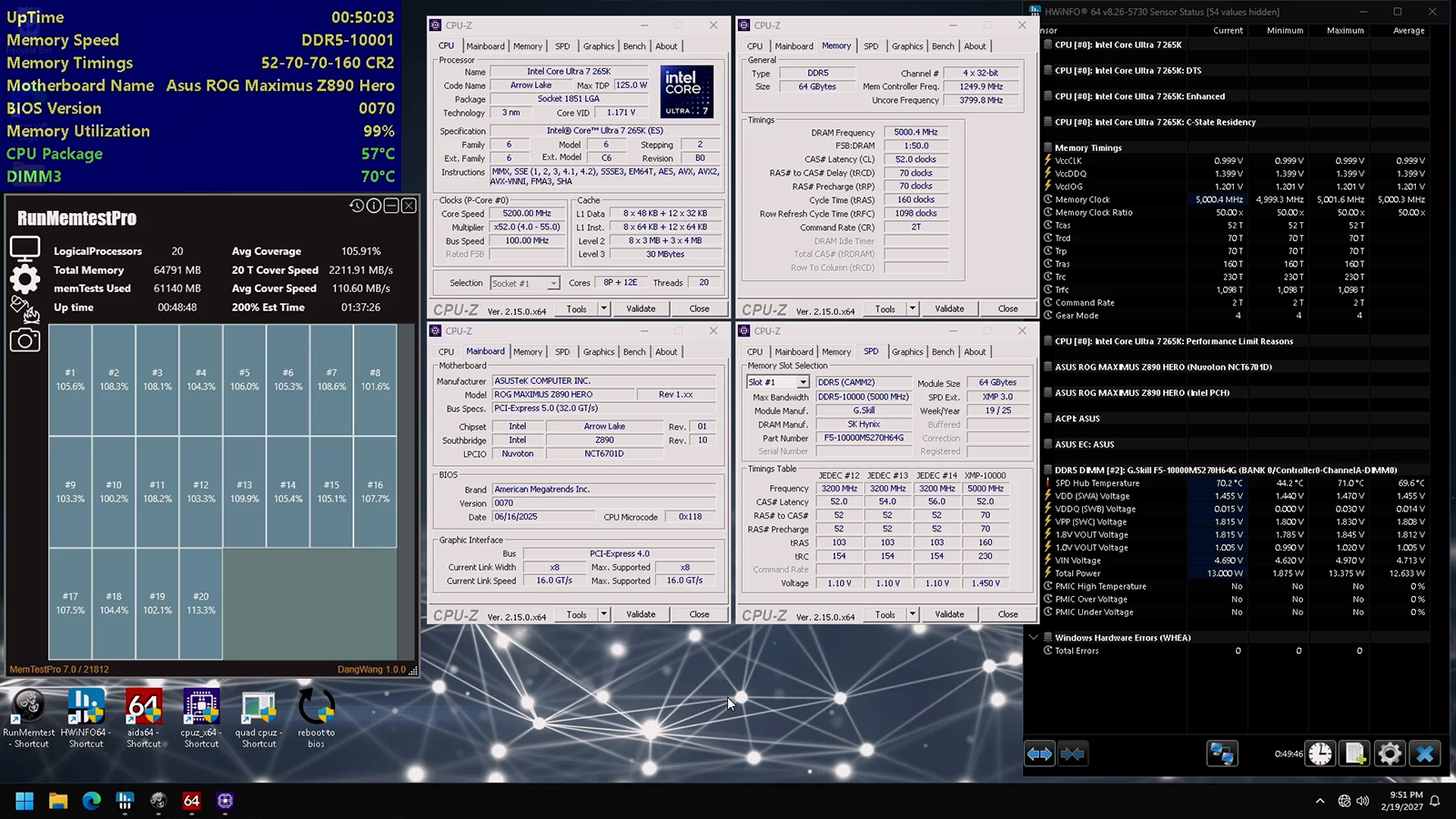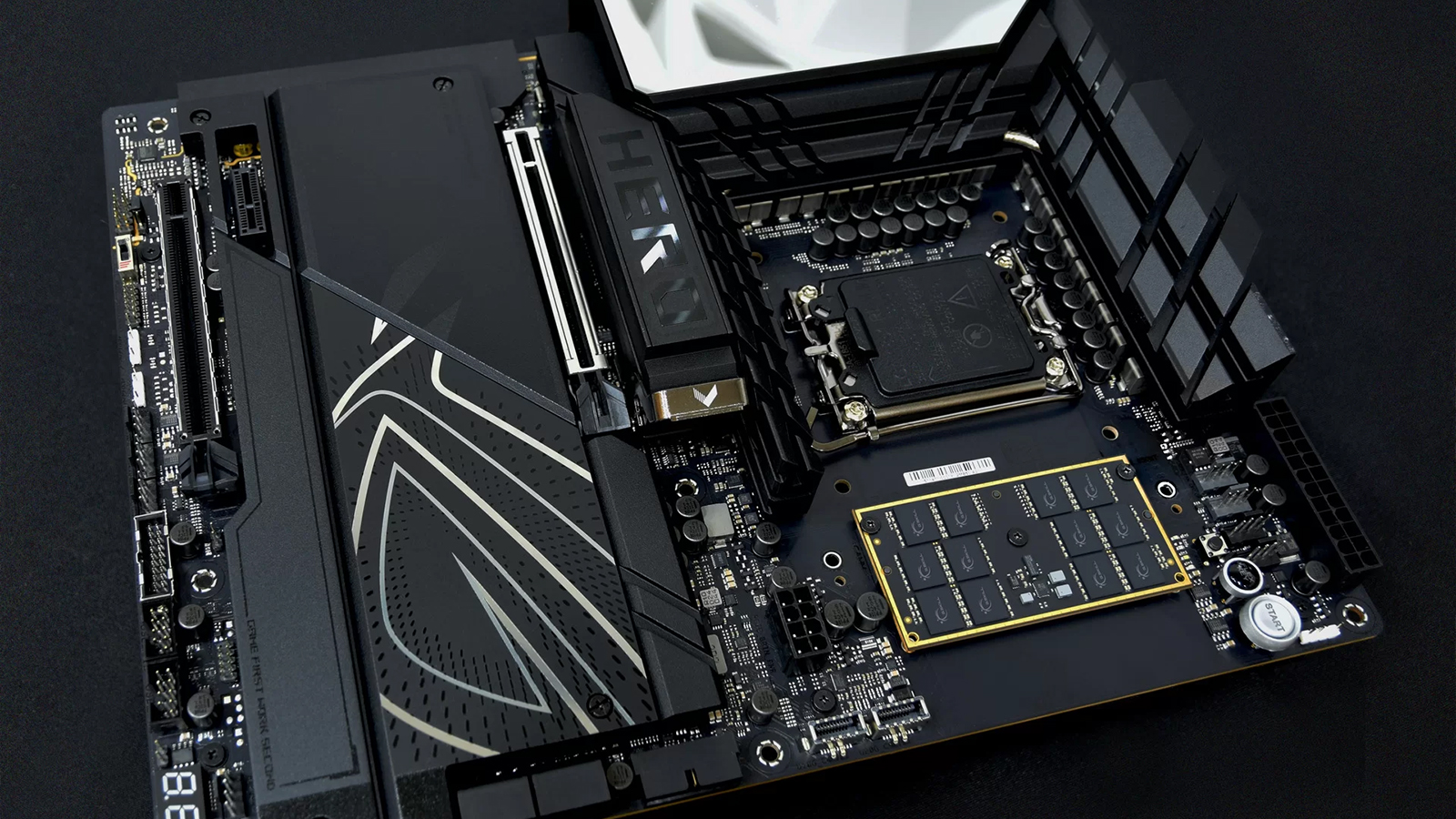G.Skill pushing new CAMM2 DDR5 memory modules to the overclocking limit — hits DDR5-10000 speeds on modified ASUS motherboard
It's not yet commercially available, but it's ready to break barriers when it comes out.

High-performance memory maker G.Skill just announced that it has hit an overclocking milestone with CAMM2. This new memory standard is designed to replace the SO-DIMM and UDIMM formats we’re used to with a thinner and faster substitute, with the first modules hitting the market around mid-2024. The company said that it hit the DDR5-10000 Memtest-stable memory speed milestone using a 64GB CAMM2 memory module on a custom Asus ROG Maximus Z890 Hero CAMM2 motherboard paired with an Intel Core Ultra 7 265K CPU.

This is a significant improvement over the official JEDEC specification for DDR5, which has speeds ranging from 4800 to 8800 MT/s. The current memory record is held by Canadian overclocker saltycroissant, who hit an eye-popping DDR5-12054 using G.Skill Trident ZS DDR5-8000 48GB (2x24GB) CL38 memory and purely air cooling. While the DDR5-10000 record achieved with CAMM2 memory modules isn’t there yet, it can potentially break that record because it was specifically designed to operate faster than the widely available SO-DIMM sticks in the market.
Despite its advantages, you’d be hard-pressed to find CAMM2 modules and motherboards on the market. Although manufacturers like G.Skill, TeamGroup, and Kingston have all shown off CAMM2 memory modules at Computex 2025, they’re still not readily available at retailers. Crucial is the only one that sells CAMM2 kits — specifically, LPCAMM2 LPDDR5X-7500 memory in 32GB and 64GB capacities. Aside from that, PC makers also haven’t released CAMM2 versions of their motherboards. So, even if you want to be on the cutting edge of tech and use CAMM2 memory for your latest build, that’s just not going to happen, at least today.

Still, the CAMM2 form factor offers advantages that make it a worthwhile investment. Because of its size advantage, laptop and handheld device makers can ditch soldered RAM on their products with LPCAMM2 modules. That way, they can have upgradability and repairability without compromising thickness. It could also cut manufacturing costs by allowing a single production line to handle all RAM capacity variants, instead of setting up separate sub-lines for soldering different memory configurations.
It will take time for CAMM2 to hit mainstream appeal, especially as DIMM is deeply entrenched in our current hardware infrastructure, arriving with Intel Pentium processors from the early 1990s. But as next-gen computing demands ramp up — from AI to AAA gaming — memory form factors like CAMM2 may finally take center stage.
Follow Tom's Hardware on Google News to get our up-to-date news, analysis, and reviews in your feeds. Make sure to click the Follow button.
Get Tom's Hardware's best news and in-depth reviews, straight to your inbox.

Jowi Morales is a tech enthusiast with years of experience working in the industry. He’s been writing with several tech publications since 2021, where he’s been interested in tech hardware and consumer electronics.
-
-Fran- I want this. I need this. Pls GIB!Reply
In any case, DDR6 and new sockets would be the best instance to make the switch. Let's see which of the two (or others) has the marbles to make the switch first; or encourage it.
Regards. -
Dementoss The image provided under the first paragraph, is useless, please publish a larger one, so the figures can be more legible.Reply -
chaz_music This was a good read. Dell did great thing by helping take their CAMM design and help JEDEC to release the public CAMM2 version for everyone. It goes a long way into reducing the RF transmission path issues that the DIMM and SODIMM sockets caused, which limits the max frequency that can be used. The PCB edge pattern will also help reduce ESD events as long as users handle the CAMM2 boards by the edges like the are supposed to do for all boards. There is a ground guard ring around the CAMM2 design to protect the sensitive tracks. This also helps stop lateral EMI from coming into the edge of the board. Kind of awesome.Reply
And I am super glad that they kept the provision for ECC. I predict that eventually, the industry will make ECC the standard memory configuration just like error corrected SSDs. Nearly all PC bus systems have error correction - except RAM. And yes - DDR5 has ECC at the chip level due to lowering the operating voltage, but not the bus going to the CPU.
The PC industry has made a phenomenal profit off the false ECC "tax" and even made users believe that it is more expensive to make/use. It isn't. You can find ECC on the most mundane $10 MCUs used in embedded applications. A hand full of transistor and some extra I/O pins and you are cooking with gas. We have ECC in our SSDs and just expect it. Why not the RAM?
There is a Google ECC study from 2011 that found a major increase in ECC hits during the solar maxima that year. The paper also concluded that they expected a significant number of Windows BSODs and other system corruptions to be caused by bad RAM reads. And for space-borne applications, I have worked with teams that took this into account and we put more stringent ECC in place. Soft errors are very common, so bit flips should be expected and handled. Most PC busses do that, except non-ECC RAM.
Thank you for the article, Jowi. -
dalek1234 Reply
If you are on a PC, right-click and select "Open Image In New Tab "(or similar wording), then zoom in on that tab (Ctrl + mouse wheel up/down). The image isn't the clearest, but the text is readable.Dementoss said:The image provided under the first paragraph, is useless, please publish a larger one, so the figures can be more legible. -
abufrejoval The CRUCIAL number (sorry G.Skill!) I am missing here is the bandwidth actually achieved, because that's where the performance comes from, clocks are perhaps the means, but at this point just a number.Reply
CAMM2 promised to be all about getting near soldered DRAM latencies and bandwidth yet retain DIMM like expandability.
So far I'm just getting all the disadvantages: extra cost, isolated, lock-in implementations, lack of standards or reusability.
Of course, it's a chicken and eggs issue, but it's been years, hasn't it? So far it has a whiff of Rambus. -
Eximo The number is the bandwidth. 10000 MT/s How memory has been measured for a while. Kind of had to stop using the old PC numbers because they got too ludicrously large. But back then it was MB/s, like PC3200.Reply -
Eximo Reply
Extra cost until it becomes a normal standard. Though I honestly think it would be short lived regardless. DRAM is likely to end up integrated, and expandable system memory will become another layer, perhaps through CXL.abufrejoval said:So far I'm just getting all the disadvantages: extra cost, isolated, lock-in implementations, lack of standards or reusability.
Of course, it's a chicken and eggs issue, but it's been years, hasn't it? So far it has a whiff of Rambus.
Not been that long really. CAMM exists from Dell. CAMM2 isn't being sold to consumers, but that is likely a decision against switching tooling mid-cycle. Until the current supply of SO-DIMMs and SO-DIMM boards is used up and it makes sense to transition to new designs.
I think the truth is that most people don't need memory upgrade capability at all. So the soldered solution is fairly easy to do.
I think it would be cool for the desktop, but that is a very small market at this point. OEMs want it cheap, not fast. Enthusiasts are maybe a few percent of the market. -
thestryker Reply
Extra cost is obvious and expected for now. I believe the only CAMM2 on the open market currently is the LPCAMM2 from Crucial.abufrejoval said:So far I'm just getting all the disadvantages: extra cost, isolated, lock-in implementations, lack of standards or reusability.
Isolated? Meaning there aren't many implementations? If so that's unfortunately to be expected due to the reality of manufacturing.
Lock-in implementations? what does this even mean? CAMM2 is a JEDEC specification which means any module adheres to that.
Reusability? What's the issue here exactly? They're no different than any other DRAM module specification.
Lack of standards? CAMM2 is a JEDEC standard so no: https://www.jedec.org/news/pressreleases/jedec-publishes-new-camm2-memory-module-standard -
dimar I was going to buy ThinkPad T16 Gen 4 but decided to wait for the next version with CAMM2 RAM instead.Reply